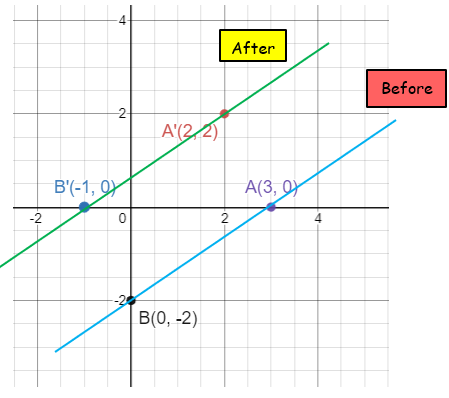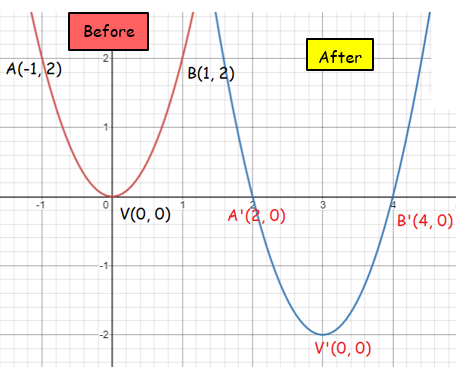FIND TRANSLATION OF A POINT ALONG THE GIVEN VECTOR
A translation moves an object from one place to another. Every point on the object moves the same distance in the same direction.
If P(x, y) is translated
h units in the x-direction and
k units in the y-direction
to become P'(x', y'), then
x' = x + h and y' = y + k

x' = x + h and y' = y + k are called transformation equations.
Example 1 :
Triangle OAB with vertices O(0, 0), A(2, 3) and B(-1, 2) is translated under the vector <3, 2>. Find the image vertices and illustrate the object and the image.
Solution :
To find vertices of image after translation, we use
x' = x+h and y' = y+k
Here (h, k) ==> (3, 2)
x' = x+3 and y' = y+2
|
Before translation O(0, 0) A(2, 3) B(-1, 2) |
After translation O'(0+3, 0+2) ==> O'(3, 2) A'(2+3, 3+2) ==> A'(5, 5) B'(-1+3, 2+2) ==> B'(2, 4) |

Example 2 :
Find the image equation when 2x-3y = 6 is translated under the vector <-1, 2>.
Solution :
Let us find any two point on the straight line 2x-3y = 6.
Converting 2x-3y = 6 into intercept form, we get
(2x/6)-(3y/6) = 6/6
x/3 - y/2 = 1
Point on x-intercept is (3, 0).
Point on y-intercept is (0, -2).
Here (h, k) ==> (-1, 2)
x' = x-1 and y' = y+2
|
Before translation A(3, 0) B(0, -2) |
After translation A'(3-1, 0+2) ==> A'(2, 2) B'(0-1, -2+2) ==> B'(-1, 0) |

Example 3 :
Find the image of y = 2x2 under a translation with vector <3, -2>.
Solution :
Let us find any three points on the parabola.
Vertex of the parabola is (0, 0)
If x = -1, then y = 2
If x = 1, then y = 2
So three point on the parabola are V(0, 0), A(-1, 2) and B(1, 2)
The image has to be translated along the vector <3, -2>.
(h, k) ==> (3,-2)
x' = x+3 and y' = y-2
|
Before translation V(0, 0) A(-1, 2) B(1, 2) |
After translation V'(0+3, 0-2) ==> V'(3, -2) A'(-1+3, 2-2) ==> A'(2, 0) B'(1+3, 2-2) ==> B'(4, 0) |

To find equation of new cure, let us find value of x and y from x' = x+3 and y' = y-2
x = x'-3 and y = y+2
Given curve :
y = 2x2
Equation of curve after translation :
y+2 = 2(x-3)2
y+2 = 2(x2-6x+9)
y+2 = 2x2-12x+18
y = 2x2-12x+16
Example 4 :
Find the image of xy = 5 under a translation with vector <-4, 1>.
Solution :
xy = 5
Finding 4 point on the rectangular hyperbola,
y = 5/x
If x = 1, then y = 5 ==> A(1, 5)
If x = 5, then y = 1 ==> B(5, 1)
If x = -1, then y = -5 ==> C(-1, -5)
If x = -5, then y = -1 ==> D(-5, -1)
Here (h, k) ==> (-4, 1)
x' = x-4 and y' = y+1
|
Before translation A(1, 5) B(5, 1) C(-1, -5) D(-5, -1) |
After translation A'(1-4, 5+1) ==> A'(-3, 6) B'(5-4, 1+1) ==> B'(1, 2) C'(-1-4, -5+1) ==> B'(-5, -4) D'(-5-4, -1+1) ==> B'(-9, 0) |

Equation of curve before translation :
xy = 5
Equation of curve after translation :
x' = x-4 and y' = y+1
x = x'+4 and y = y'-1
By applying x as x'+4 and y as y-1, we get
(x+4)(y-1) = 5
xy-4x+4y-4-5 = 0
xy-4x+4y-9 = 0
Draw the preimage and image of each triangle under a translation along (-4, 1).
Example 5 :
Triangle with coordinates
A (2, 4) B (1, 2) and C (4, 2).
Solution :
Translation vector is (-4, 1), then move each 4 units left and 1 unit up. Original points will be in the form (x, y), after translation the new points will be in the form (x - 4, y + 1)
- A(2, 4) ==> A'(2 - 4, 4 + 1) ==> A'(-2, 5)
- B(1, 2) ==> B'(1 - 4, 2 + 1) ==> B'(-3, 3)
- C(4, 2) ==> C'(4 - 4, 2 + 1) ==> C'(0, 3)

Example 6 :
A translation along the vector 〈−2, 7〉 maps point P to point Q. The coordinates of point Q are (4, −1) . What are the coordinates of point P? Explain your reasoning.
Solution :
Translation vector is (-2, 7). Point P is translation with the translation vector and get the new position Q(4, -1).
(x, y) ==> (x + h, y + k)
Here (x - 2, y + 7)
P(x - 2, y + 7) ==> Q(4, -1)
x - 2 = 4 and y + 7 = -1
x = 4 + 2, y = -1 - 7
x = 6, y = -8
So, the required point is P(6, -8)
Example 7 :
Find the coordinates of the image under the transformation ⟨6, -11⟩.
a) (x, y) ==> b) (2, -3) ==>
c) (3, 1) ==> d) (4, -3) ==>
Solution :
The given transformation is (6, -11).
- a) (x, y) ==> (x + 6, y - 11)
- b) (2, -3) ==> (2 + 6, -3 - 11) ==> (8, -14)
- c) (3, 1) ==> (3 + 6, 1 - 11) ==> (9, -10)
- d) (4, -3) ==> (4 + 6, -3 + 11) ==> (10, 8)
Kindly mail your feedback to v4formath@gmail.com
We always appreciate your feedback.
©All rights reserved. onlinemath4all.com
Recent Articles
-
Digital SAT Math Problems and Solutions (Part - 146)
Apr 18, 25 06:52 AM
Digital SAT Math Problems and Solutions (Part - 146) -
Logarithmic Derivative Problems and Solutions
Apr 16, 25 09:25 PM
Logarithmic Derivative Problems and Solutions -
Digital SAT Math Problems and Solutions (Part - 145)
Apr 16, 25 12:35 PM
Digital SAT Math Problems and Solutions (Part - 145)

